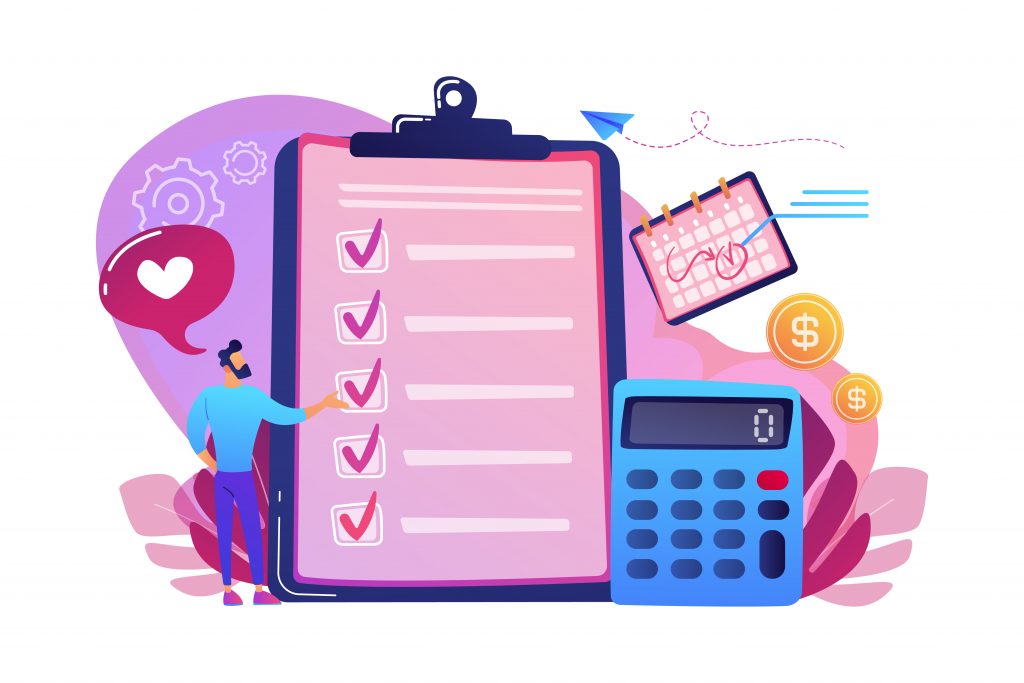Financial planning, in essence, is the difference between people who are intimidated by money matters and ones who live a financially secure life. Although personal financial planning might seem like an overwhelming exercise, we can assure you that it is not. It is important to understand that financial planning is more than just calculating your expenses and saving. It contains aspects such as investing for financial goals, which could range from a steady flow of income after retirement to purchasing your own house.
Financial Planning – What is it?
Financial planning is, in a nutshell, the process of making comprehensive decisions for spending, borrowing, saving, and investing to achieve financial goals. It is a lens through which you can see a clearer picture of your current stance and future financial goals.
If you are just starting out, do not worry. Follow these six personal financial planning steps to create a solid foundation to secure your future.

#1 Perceive where you stand
First and foremost, understand where you stand in terms of money. It is perhaps the most vital and overlooked step.
What do you need to know?
● Your assets, savings, income, expenses, and investments
● Liquidity of your assets
● Your income-to-expenditure ratio
● Your housing expenses
● Activity or item which consumes most of your money
If you assess your current financial position clearly, you will have a baseline ready. From there on, measuring your progress becomes simplified.
If you assess your current financial position clearly, you will have a baseline ready. From there on, measuring your progress becomes simplified.
#2 Set your financial goals
The process of setting financial goals is perhaps the most misunderstood part of personal financial planning. We often disregard the tangibility of our goals.
Financial Goal – What is it?
A financial goal is an objective or a target to aim for, within a certain period. Examples can range from saving for family trips, becoming debt-free, to buying a car. Financial goals vary from person to person depending on their income, desires, and priorities.
Why is it important to have financial goals?
● Gives you a purpose and direction
● Pushes you to save
● Motivates you to be thrifty
● Gives you a sense of accomplishment
● Helps you realize your dreams
Financial goals are important because it motivates you to be financially organized and forego short-term gratification in favor of long-term benefits. It is important to focus on how realistic each goal is and how you can set out to realize each goal. For tracking purposes, you may consider breaking down your goals into small and manageable portions.

How to go about setting financial goals?
Here is what we recommend:
1. List your goals on a spreadsheet in ascending order–short-term to long-term.
2. Focus on how realistic each goal is and think about how you can achieve it. Set a realistic time frame for each goal (feel free to include seasonal goals).
3. Track the progress of your financial goals regularly.
Achieving goals does not mean you have to change your habits abruptly. Instead, take small and consistent steps towards it. Do not be in a rush, as personal financial planning is often a long-term process. Try taking it one step at a time.
#3 Action towards pay down
Unfortunately, it is extremely common that people do not make clever use of their debts, thus falling into debt traps with a high interest payment. This is especially unfortunate when we realize that there are NBFCs and leaders in the FinTech space that offer instant and hassle-free personal loans at extremely low interest rates, very much like products on offer at StashFin. However, if you are an unfortunate victim of having to pay overpriced debts that bog you down, consider the following tips.
Tips to pay off your toxic debts
- Reduce your spending.
- Consider side jobs and other activities that increase your income.
- Consolidate your outstanding debts into a scheme that has lower interest rates.
- Take one personal loan at a low interest rate that covers most of your debts. For instance, you could consider taking a low-interest loan from StashFin to pay off your high-interest credit card debts.
Writing off toxic debts should be a high-priority task on your spreadsheet so that you can focus on the actual goals.
#4 Investment
Investments are the key to achieving long-term financial goals, like retirement. Currently, everyone has access to countless investment avenues that yield substantial returns in the long run. Apart from achieving long-term goals, investments also have the added benefit of endowing a sense of discipline, if done correctly.
Investment options are broadly classified into active and passive. Usually, unless you have abundant experience in the stock market (or any investment avenue of your choice – the stock market is the most popular avenue of investing), it is recommended that you speak with a financial advisor to see how you can build your portfolio. It is important to not fall for the “lucrative strategy” of trying to time the markets (i.e., buy the lows and sell the highs) because it never works. What would be more beneficial is to focus on the time in the market – Attempt to buy securities, hold for the long run, and liquidate only when you need the money to survive.
#5 Emergency fund
Emergency funds are the sums of money or other assets that you allocate for unforeseen situations like medical expenses, unemployment, and natural disasters.
Life is full of surprises, and that is exactly why you need to save a portion of your income as an emergency fund. The recent COVID-19 pandemic has made people realize the importance of having an emergency fund. It is important to build an emergency fund containing sufficient money to keep you afloat for 3-6 months without needing to borrow funds.
How to raise an emergency fund that protects you?
- Dedicate a part of your savings to an emergency fund every month
- Use a separate account for this purpose.
- Short terms mutual funds can be considered to park your emergency funds. Look for funds that offer better liquidity, security, and accessibility
- Allocate a major portion of windfall money to the emergency fund
- Curtail on your leisure expenses and direct it towards your contingency account
Try your very best not to compromise your future goals for short-term luxuries. Try not to sell off your investments and long-term holdings in case of an emergency. You may always avail of low-interest short-term loans on offer by StashFin to meet your liquidity needs.
#6 Habituate the process
A plan without action has no value. If you really want to ensure that you work towards the financial goals you have set, you must hold yourself accountable and necessitate financial discipline. You need to monitor your funds, income, and expenditure regularly. Once you habituate, everything becomes simplified and you get clarity and stability.
Remember that it is never too late to begin your personal financial planning. Even if you have a negative asset flow, consistency and shrewd financial habits can turn the tables for you. However, start planning your finances now – the earlier you begin, the sooner you will reach your goals.
If you are looking for ways to achieve financial stability, be on the lookout for more informative posts on the StashFin blog.




